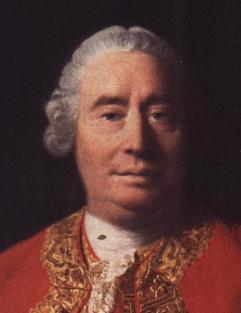 One of the passages in the writings of David Hume that sets out what is known as "Hume's fork" runs this way:
One of the passages in the writings of David Hume that sets out what is known as "Hume's fork" runs this way: All the objects of human reason or enquiry may naturally be divided into two kinds, to wit, relations of ideas, and matters of fact. Of the first kind are the sciences of geometry, algebra, and arithmetic, and in short, every affirmation which is either intuitively or demonstratively certain. That the square of the hypotenuse is equal to the square of the two sides, is a proposition which expresses a relation between these figures. That three times five is equal to the half of thirty, expresses a relation between these numbers.
Propositions of this kind are discoverable by the mere operation of thought, without dependence on what is anywhere existent in the universe. Though there never were a circle or triangle in nature, the truths demonstrated by Euclid would for ever retain their certainty and evidence.
Matters of fact, which are the second objects of human reason, are not ascertained in the same manner; nor is our evidence of their truth, however great, of a like nature with the foregoing. The contrary of every matter of fact is still possible, because it can never imply a contradiction, and is conceived by the mind with the same facility and distinctness, as if ever so conformable to reality. That the sun will not rise tomorrow is no less intelligible a proposition, and implies no more contradiction, than the affirmation, that it will rise. We should in vain, therefore, attempt to demonstrate its falsehood. Were it demonstratively false, it would imply a contradiction, and could never be distinctly conceived by the mind.
That isn't the only such passage. At another place, he puts it in a more lively way:
When we run over libraries persuaded of these [empirical] principles what havoc must we make? If we take in our hand any volume of divinity or school metaphysics for instance let us ask, Does it contain any abstract reasoning concerning quantity or number? No. Does it contain any experimental reasoning concerning matter of fact and existence? No. Commit it to the flames for it can contain nothing but sophistry and illusion.
And now at least some of the people googling the phrase "Hume's fork" will find this on my blog.
Welcome! Now that you're here, I hope you look around.
Comments
Post a Comment